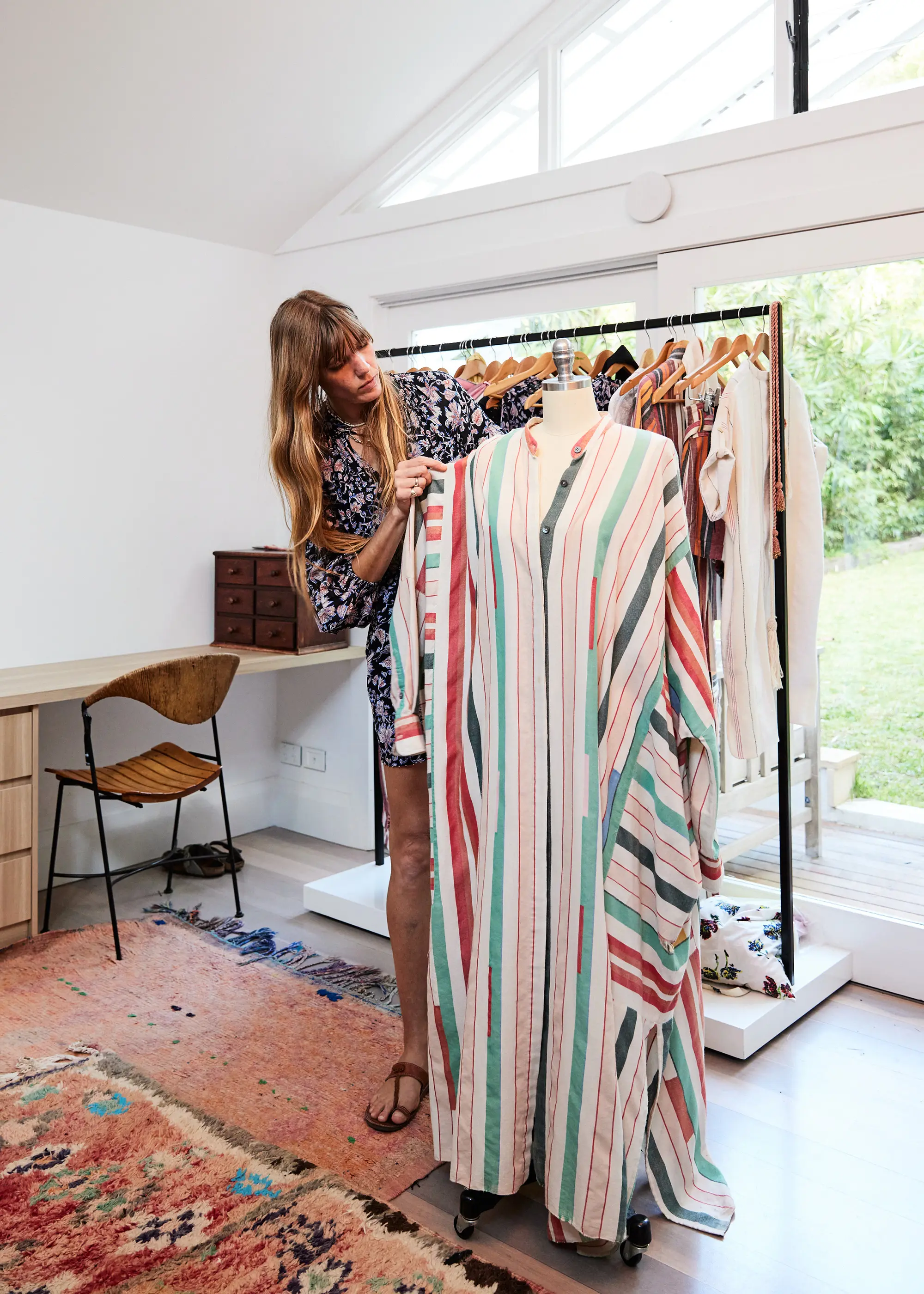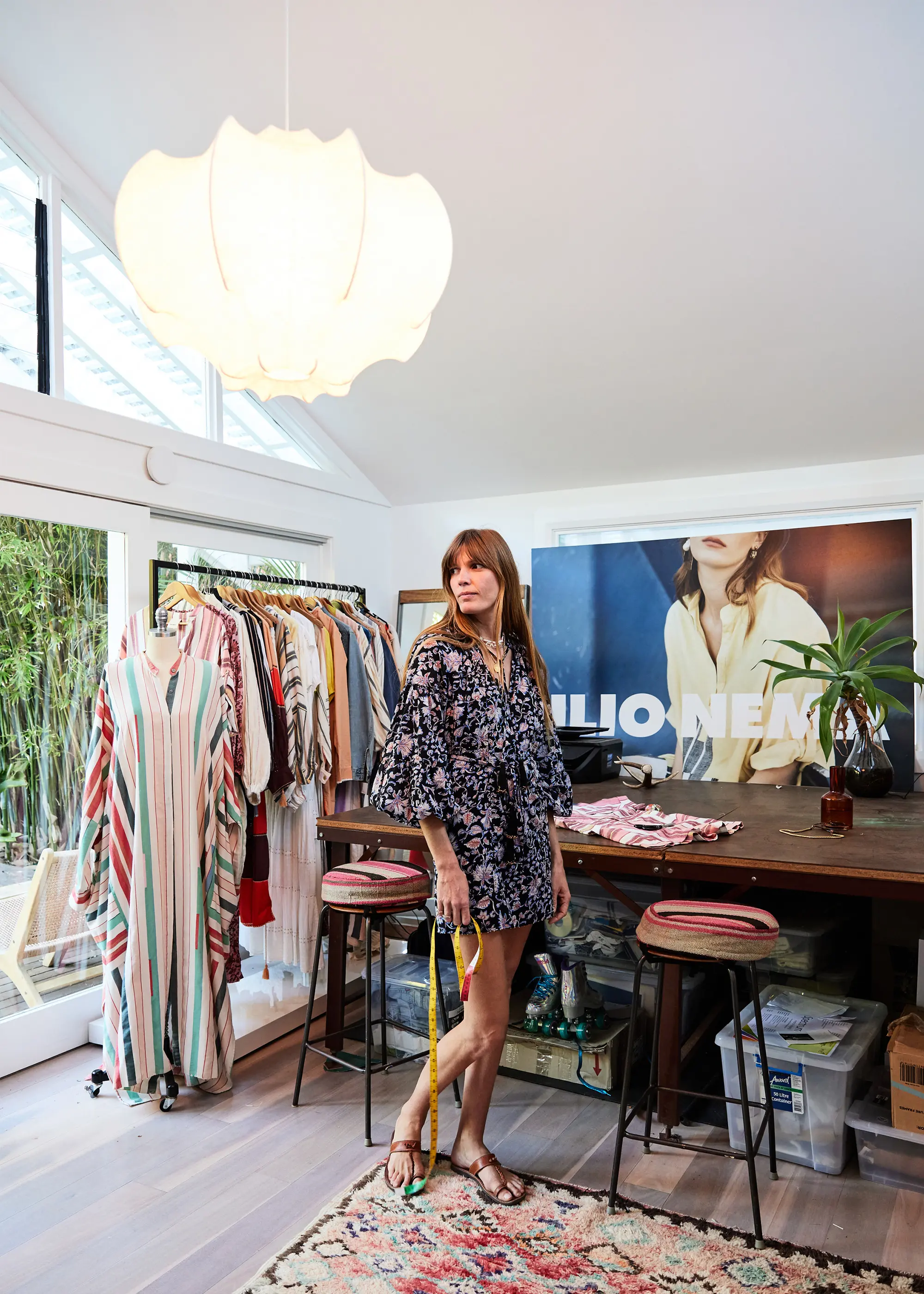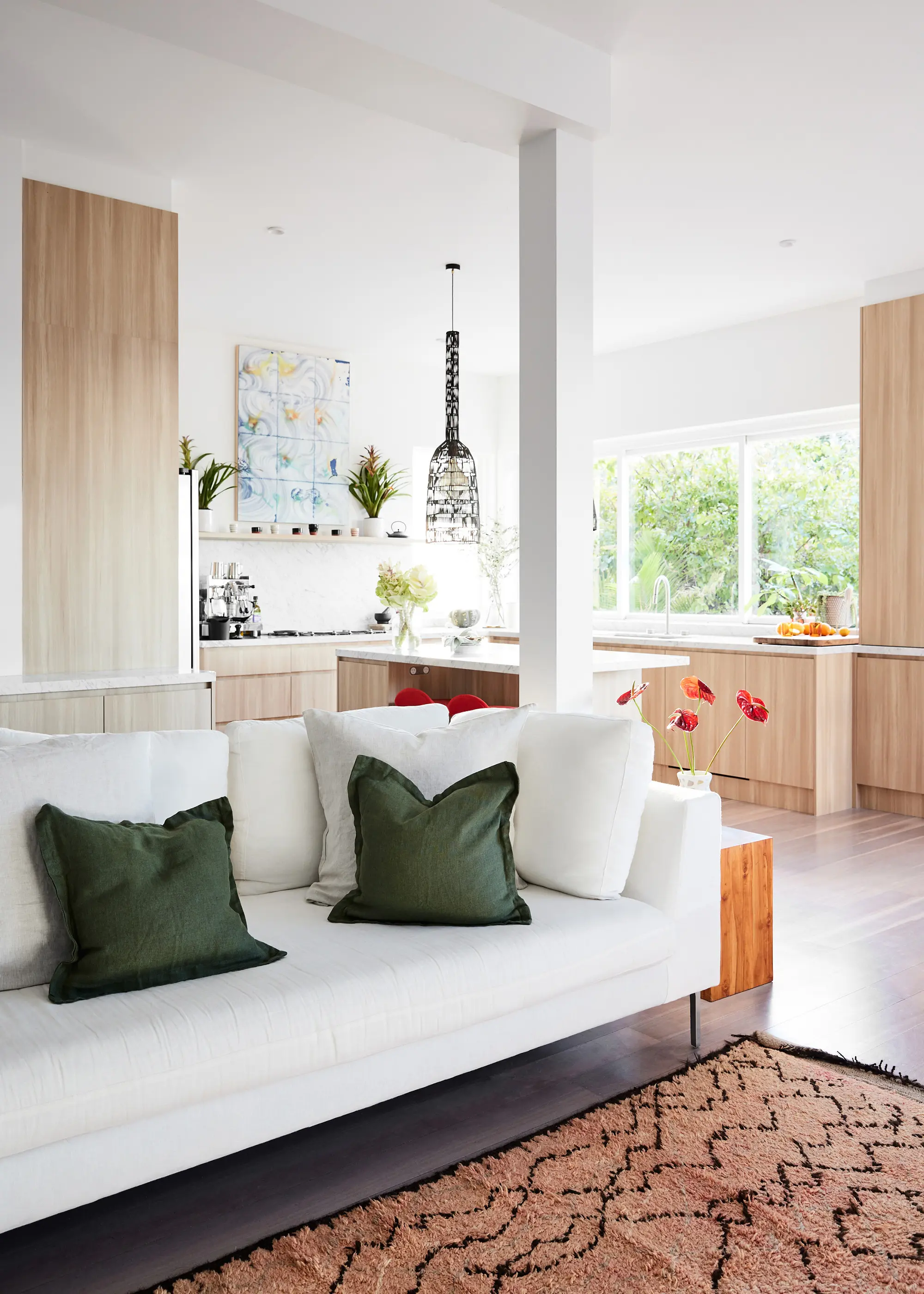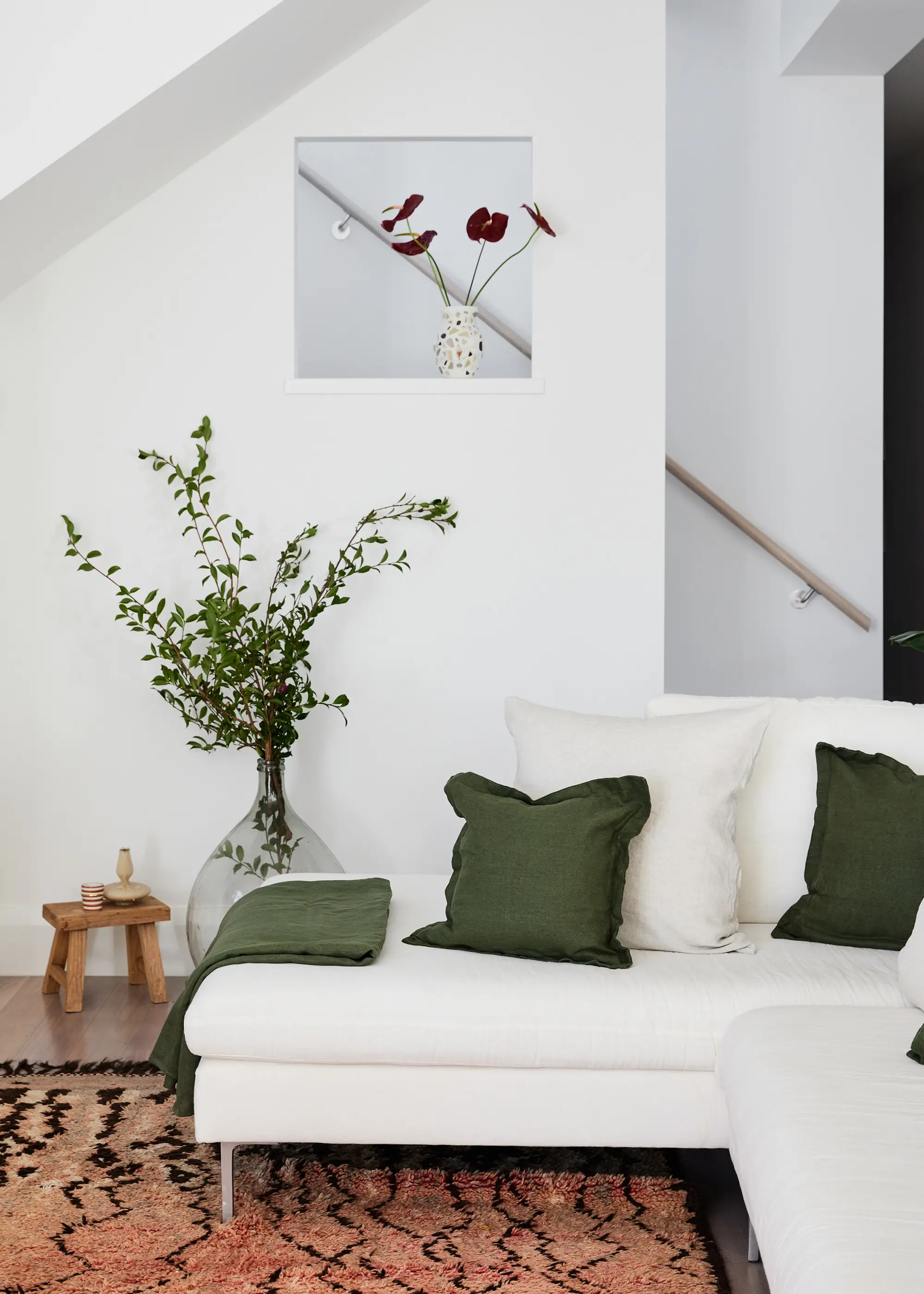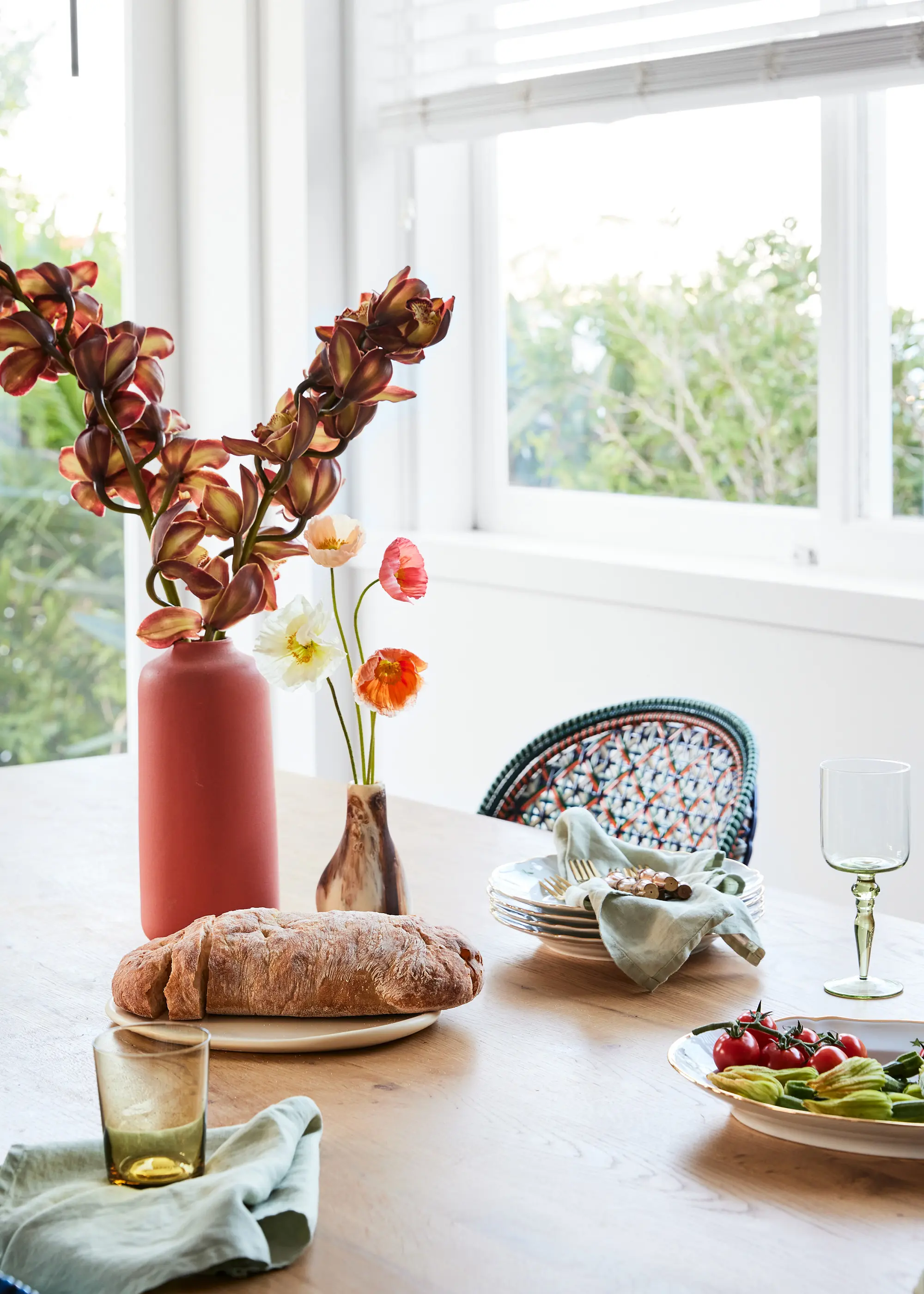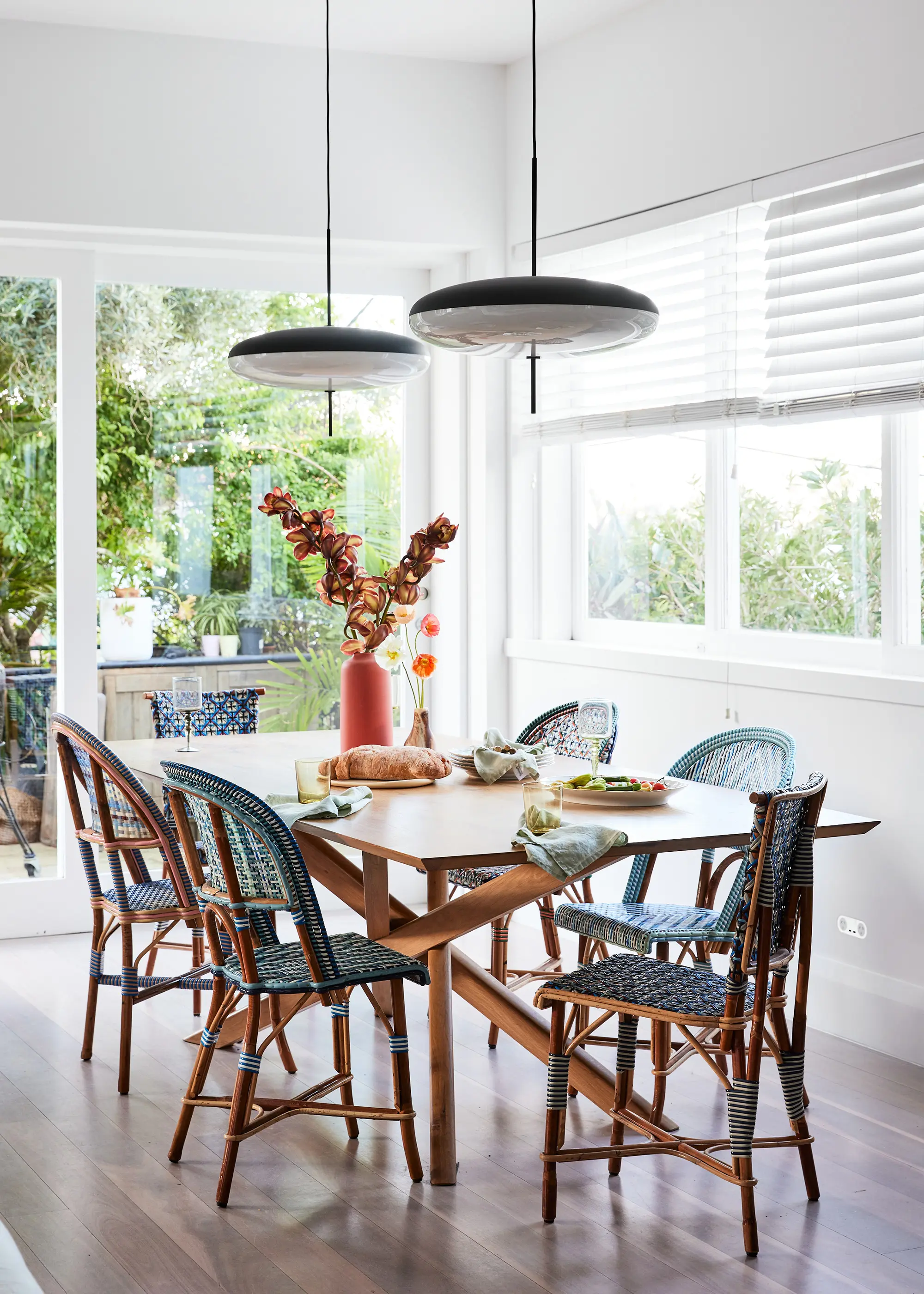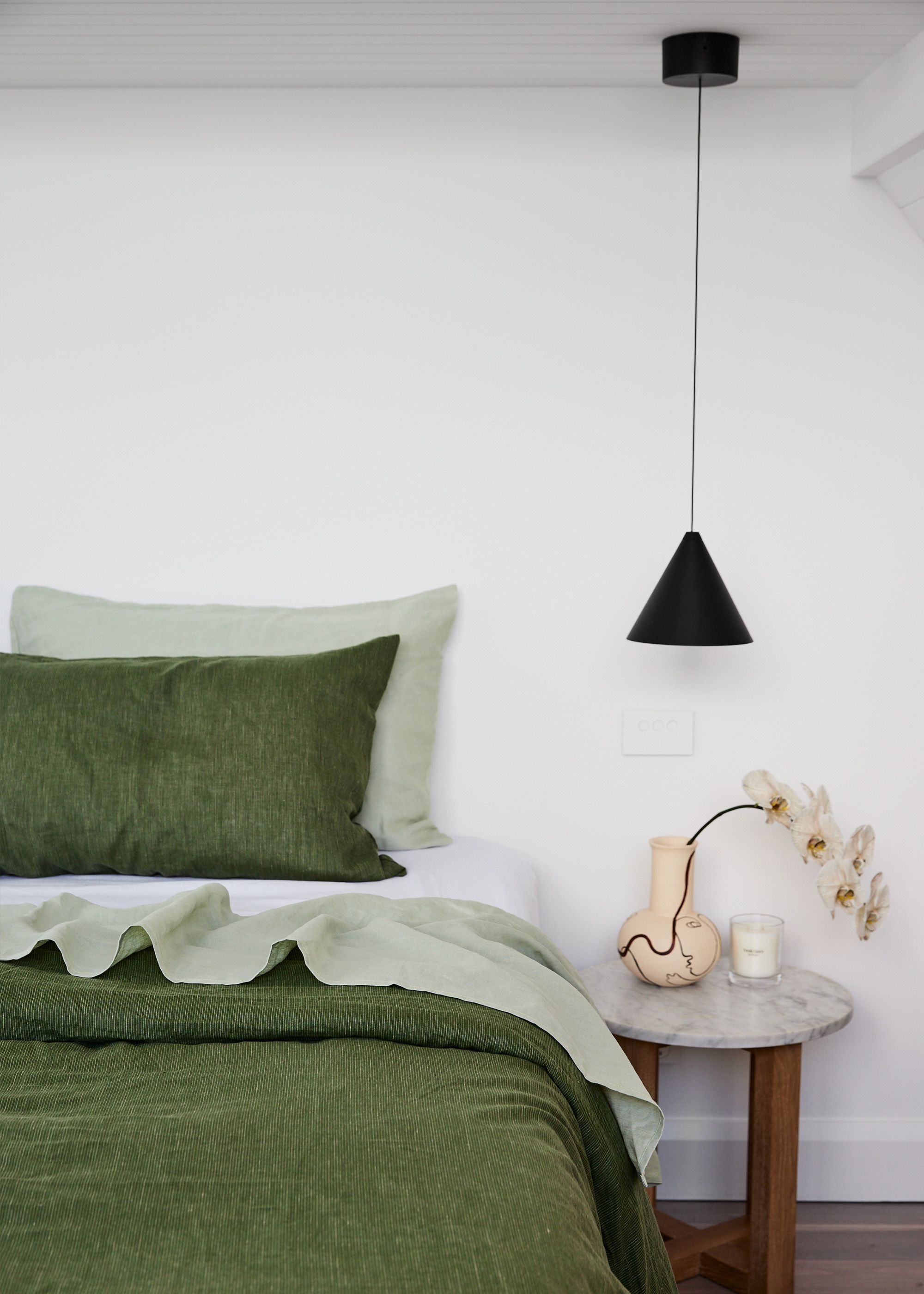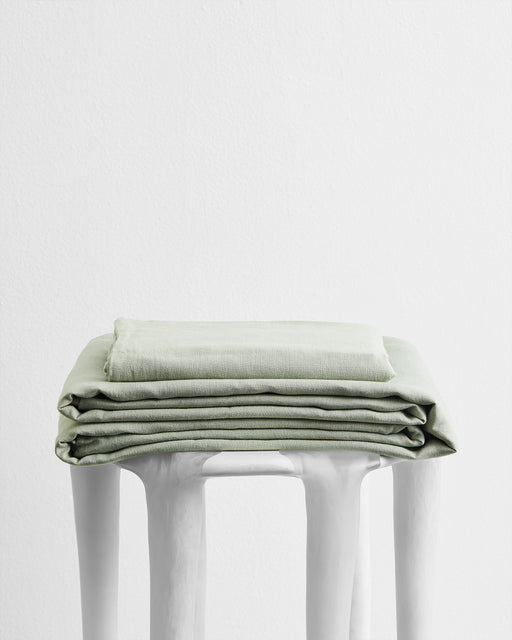
Inside Fashion Designer Ariane Leondaridis' Modern Eclectic Home
The ILIO NEMA co-founder's space playfully showcases her vibrant style.
Welcome to The Makers. Each week, we celebrate innovators, artisans, and crafters of all types by taking you on a private tour of their creative spaces. For this instalment, we head to Sydney, New South Wales where fashion designer and co-founder of sustainable resort wear brand ILIO NEMA Ariane Leondaridis lives in a colourful coastal paradise.
Being a Paris native and modelling from the age of 18 for luxury names like Castelbajac and Martin Margiela is the life that many people dream of, and it's one that's a reality for Ariane Leondaridis. The model, now fashion designer, has always been surrounded by bountiful sources of inspiration. After her years in front of the camera and on the runway, Ariane used her exposure to the industry to carve a different path behind the scenes.
She began interning at Margiela, assisting at multiple fashion weeks, then working her way up with the atelier helping with fittings and styling runway shows. After gaining invaluable knowledge over these years, she decided it was time for a seachange, and packed up her life to pursue a fashion career in Sydney. Ariane worked for various fashion houses over the next few years, moving to New York in the process and working as head designer for Ulla Johnson, which revived her love for traditional artisanal craft.
After returning to Sydney she stepped back from her role at Ulla, but continued to work there as a freelancer, while she began her own endeavour which would inevitably change the course of her career. The pandemic hit in 2020 and Ariane saw the perfect opportunity to pursue a lifelong dream of creating her own sustainable line of resort wear, and consequently, ILIO NEMA was born. Founded by Ariane and her business partner Katia Kelso, ILIO NEMA emerged from their mutual commitment to sustainable design. Their ethos is simple: to counteract trend-based consumption by reintroducing timeless and traditional craftsmanship to modern life.
Ariane purchased her Sydney home two years ago, first falling in love with the breathtaking ocean views and natural light that fills the spaces through its multiple north-facing windows. The home came nearly perfect, only needing a fresh lick of paint and some kitchen and bathroom renovations prior to moving in.

Almost all of the furniture she filled the space with had travelled from her home in New York, “I was a bit scared at first, but weirdly everything found its spot,” she shares with Bed Threads Journal. A plethora of eye-catching pieces fill up Ariane’s Sydney home, her Roche Bobois Mah Jong sofa being the main attraction in the sun-drenched corner of her living room, with rich paprika velvet contrasting the crystal blue waves that sway in the distance.
Her home studio is where her colourful ILIO NEMA creations come to life. Surrounded by natural fibres and colour swatches, Ariane uses this room not only to create, but to also inspire. Her bedroom in comparison is much more stripped back, with minimal clutter and decorations creating a sleep sanctuary reserved for rest and relaxation. An air of tranquillity filters through her bedding choices, too, with tones of Olive Stripe, Sage and White complementing the calming aesthetic.
We were lucky enough to tour Ariane’s colourful coastal home and talk to her about what sustainability means to her as a designer, and the ILIO NEMA Spring/Summer collection she has been working on.
Hi Ariane! This series is called The Makers. What is it that you make?
I have a fashion label called ILIO NEMA. Colours and textiles are my favourite things, and we make beautiful, technicolour slow-process resort wear. I mostly design with handwoven cotton textiles, working closely with weavers, hand-loomers and artisans in India and Morocco to develop our own one of a kind fabrics.
How does the act of “making” relate to your personality and who you are?
I have always liked doing things with my hands: I draw, I paint, and do ceramics, and weave, I knit, I crochet. I am very tactile and I feel at my best when making something by hand. It makes me feel connected to myself and the present moment. It is meditative, it’s healing, and it’s just what I do best to express myself.
Tell us about your career journey to date. Did you always know you wanted to pursue a career in fashion?
I have always liked to draw and as a child always loved art, museums and galleries, archaeology and old treasures. I was always attracted to craft. I would braid flowers together, or redecorate my room, or draw with chalk on the footpath. It was obvious I was creative, but fashion only started interesting me when I was in my early 20s. The first time I picked up a sewing machine I would have been 20.
I grew up in Paris and did a bit of modelling when I was 18, and I think that is really what sparked my interest in fashion. I worked with incredible creative designers like Castelbajac or Martin Margiela, and my views of fashion shifted from the superficial glamorous aspect of things to a more intellectual, artistic point of view, which matched my personality better. It was never about just a pretty frock to look sexy, but more about cuts and details and tailoring and draping, and then colours and textures, and scale. More the way a painter would approach his art.
After modelling for Martin Margiela, I started interning there on the men's design team, and then I was assisting Martin during fashion weeks for a couple of years, doing everything from working with the atelier, to assisting on the fittings and styling runaway shows. I learned a lot there. Then I decided I needed more sun in my life, and took a job in Sydney at WILLOW as a design assistant. It was a lovely experience which taught me lots, because it was a really small team and I had to cut and saw, and be very hands on the product.
After two years, I decided I wanted to keep exploring the world and went to New York, and worked for THAKOON as head designer, and then ULLA JOHNSON as Design Director, which really revived my love for artisanal crafts and ethnic designs. I came back to Sydney late 2018, I kept freelancing for ULLA for a year, while making my own prototypes with artisans in India and Morocco, mostly for fun! It was in 2020 (when Covid hit), that the idea to launch my own label appeared. My business partner Katia happened to move back from New York to Sydney and it felt like the perfect timing.
How do you create a collection? What is your process?
It all starts with the fabric for me. I usually paint stripes for days, work on colour stories, make little stitching swatches by hand, and send that to my weavers to work on and translate into fibres. And then it’s a long back and forth of little desk looms and swatches, and Pantone codes, always trying to work with minimum resources to be the most sustainable possible, and avoid creating unnecessary waste.
Once I have my fabric ready, always natural fibres, mostly organics, I start deciding the silhouette I want to make in each fabric, and I organically then try to balance the collection from there. My inspiration for the stripes I paint, and the designs usually come from nature around me or art. so I am always looking for some interesting galleries to visit, or new things to see…
What’s been the single most crucial tool or strategy you’ve used to further your career?Hard work. Martin told me once, it doesn’t matter how long it took you to make something, it’s the end result that counts. And I feel like fashion has so much of that “suffering” of endless hours of trials and errors, and failed prototypes… and you just have to put in the hours.
Sometimes, the first idea is the good one, and it gets executed very easily, and sometimes you have to go back to the drawing table constantly and nothing looks good. But at the end of the day, when it’s showtime, things have to look effortless! And no one should be able to see all the hard work, sweat and tears and sleepless nights you have put in. It’s quite a crazy industry, and there is always an emergency! So hard work has always been my best strategy.
What’s been the best thing that’s happened to you since you started your career?
The best and worst thing I would say is having burnout. I think it taught me to make myself a priority, and manage my mental health better. I am happier now, I have a better work-life balance and ultimately the quality of my creativity has soared. Of course I have had some highs, like dressing Emma Stone for the Met Gala, or Anna Wintour, or Charlize Theron for some award night… etc but at the end the personal lessons are the better ones.
Do you have a single piece of advice you’d give to your younger self or someone hoping to make it in the fashion world?
Be true to yourself would be my best advice to my younger self, it took me a while to find that confidence that I was good enough – what a waste of time! Otherwise, to a fashion student I would say: try as many things as you can. There are so many jobs in the fashion industry. Try the design team, the atelier, or the sewing room, try to assist stylists on photoshoots, or try working with photographers, or press offices, or sales showrooms – it’s vast. And also, always be kind to everyone – it’s a small industry! What goes around comes around.
Sustainability is central to Ilio Nema’s ethos – what does “sustainable fashion” mean to you?
Limiting our footprint in our designing and production process and having the smallest impact possible and reducing waste. So, it means working with materials that are already available, instead of demanding more. Sometimes, I start my colour stories by asking what shades are already available and need to be used up, or what leftover fabrics do the mills have so they don't have to go to landfill.
We also work with fibres that are near the weavers, and then near the tailors. Basically, nothing has to ship from one corner of the world to the other. Our cotton comes from the south-west of India, the weavers are in the south in Coimbatore, and the atelier is near Delhi. We try to work with natural dyes, and use only natural fibres.
We also don't use plastic, we make our packaging pouch out of our leftover fabrics, and ship in compostable envelopes. Our tags and postcards are recycled paper. We consolidate shipments so we don't ship packages every second day to our factories and we are very mindful with our timing around that. And then finally, we make small runs and we don't overproduce, so that we don't have to go on sale to get rid of extra inventory which totally devalues the work of our artisans. And also it makes our product more exclusive.
Lastly, I sketch on my iPad so that I don’t churn through paper anymore! That's actually a huge improvement from a technology standpoint.
Now, the home stuff. How long have you lived in your home?
I have been in this home for 2 years now.
How did you initially know this was the space for you?
It took us over two years to find the right place. The market was really challenging, and we really wanted to be near the ocean. It was a must, and there weren’t many options! I think what I loved most about this house was the light and its north-facing, ocean views. It’s a white beach house with tons of windows and sliding doors – nothing fancy, but it’s very light and uplifting inside. The sunrise appears straight through my bedroom window. It’s heaven. Also, that bougainvillaea spilling from the terrace just made my heart sing. It is very relaxed and it has a European vibe to it. I don't really love ultra-modern places, so I was happy it wasn’t a renovated house.
Did you do any renovations or make any big changes after moving in?
We did the strict minimum to it. We repainted the outside and inside to freshen up, sanded the floors and did some cosmetic work to the bathrooms and kitchen which were very dated. But that’s it. And lots of gardening! We wanted the terrace and garden to feel like a little oasis.
What was the thought process behind the way you’ve styled the interior? Is there a crossover between your interior and fashion styles?
Everything in the house came from our New York apartment, so with the exception of a few chairs, nothing is new. I was a bit scared at first, but weirdly everything found its spot. Even the seven rugs I brought back from Morocco are finally all out after years in storage.
I definitely love lots of colour and textures. Since everything is so light and white, I like to bring interest with the textiles. I don't do minimal so well. I love it but I am such a treasure hunter. I have too many baskets, vases, and shells everywhere! I can’t help myself. And yes, I think that’s how the style of my home reflects ILIO NEMA’s aesthetic – it’s happy, it’s cheerful, it’s bold and so rich in craft.
What are your favourite pieces in the home?
Hmmm, I have a few – there’s a really cool mirror from Scarlet Splendour in the entryway that is fabulous. I also adore my dining chairs from Philip Model. They are Bistro chairs, but woven in Africa from multicoloured disregarded plastic material. The paprika-coloured Mah Jong couch upstairs. And a painting by Jordan Kerwick from on top of the fireplace.
Do you have any special décor pieces you’re looking to add?
Yes, I would like to get more of those Roche Bobois Mah Jong couches to make a huge angle couch. I have two pieces right now but I would love three more, just to make this room a complete bohemian slouchy lounge. And also a piece of art from Marissa Purcel, namely her pink/silver ones to go on one of the walls upstairs.
Which is your favourite room in the house?
I love our upstairs parent retreat room – we call it the party room! My husband has all of his musical instruments, and his music studio, so there are lots of late music nights up there. But also it’s filled with sunshine all day long, with sliding doors opening the entire room on the ocean. We have my favourite Roche Bobois couches in there, with that rich paprika coloured velvet, and those huge fisherman net lights hanging above. Very quirky.
What are your top tips for a well-styled bedroom, and home generally?
I would say make it personal, it’s yours. Not a museum. Don't try to get everything when you move in and don't buy everything new from a catalogue right away. A house takes years to fill in with memories and to become your home. So, just wait for those little treasures you will find on a trip far away, or the special piece of art that you take years to find but you know it’s the one the first time you see it. I really find so much joy in having those types of objects around me, they tell my story.
Do you have any projects coming up you’d like to talk about?
I'm really excited about our Spring/Summer collection collection we’re working on. We are starting to develop the range more and bring in new techniques, and even some little crochet pieces from Peru, chambira bags from the Amazonian region, and more beautiful handwoven textiles!
It’s so exciting to be able to do more, and slowly deepen our relationship with the artisanal communities we work with.
For more from Ariane follow her @arianeleondaridis @ilio_nema
Photography by Alisha Gore. Styling by Sami Simper.
Enjoyed This?
Discover more creative homes.









